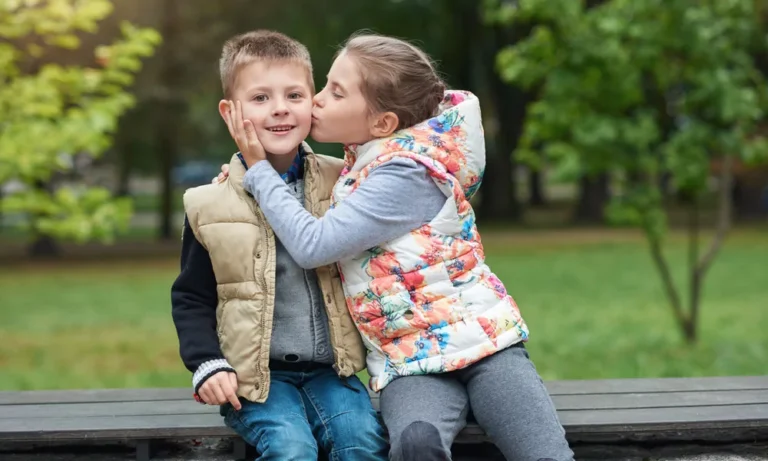Understanding early sexual curiosity
Public discussions about childhood sexuality often focus on extreme cases, such as news stories of pupils being excluded from school for “inappropriate” behaviour. In many cultures adults expect children to be asexual, so any sign of sexual curiosity can provoke discomfort. However, developmental research shows that physical exploration and curiosity about bodies are part of growing up. In preschoolers, common behaviours include touching or rubbing their own genitals, showing genitals to siblings or peers and standing very close to other people.
Children under five may talk about bodily functions or role‑play “doctor” games, and these activities are considered typical when they are playful, voluntary and involve peers of a similar age. Because sexual development varies between children, it is important not to automatically interpret curiosity as a problem or assign shame or criminal labels.
Normative behaviour continues through the early school years. Between ages 5 and 9, many children become more modest, ask for privacy and engage in games such as “show me yours/I’ll show you mine.” They may kiss or hold hands with friends, use slang words and laugh about bodily functions. During pre‑adolescence (roughly ages 9–12) children typically want greater privacy, masturbate in private, and may experiment with kissing, flirting or telling sexual jokes with peers.
Adolescents often continue this progression, exploring romantic relationships, masturbating in private and sometimes viewing sexual content, though sexual activity should remain consensual and age‑appropriate.
Recognising concerning behaviour
Professionals emphasise that not all childhood sexual behaviour is healthy. Typical behaviour is usually curious rather than coercive, occurs among children of similar age or development and does not cause physical or emotional harm. Red flags include persistent behaviour that cannot be redirected, actions that cause distress or pain, sexual play involving force or coercion, and knowledge of adult sexual acts far beyond what is expected for the child’s age. In children under four, concerning signs include forcing another child to engage in sexual play, touching animal genitals or repeatedly masturbating despite being told to stop. In school‑age children, warning signs include persistent nudity, rubbing genitals on others or discussing sexual content extensively. For pre‑teens, chronic peeping or exposing, pre‑occupation with pornography and forcing other children to expose themselves may indicate problematic behaviour.
How adults can respond
When adults witness sexual behaviour between children, researchers suggest staying calm and focusing on teaching appropriate boundaries. The Virtual Lab School recommends a four‑step strategy: pause to collect your thoughts, calmly redirect the child to another activity, listen to understand what they were doing, and teach simple rules about body autonomy. Children need to learn the proper names for their body parts and understand that “private” areas are covered by a swimsuit. While touching one’s own body is normal, caregivers can explain that such behaviour belongs in private spaces and redirect attention when it occurs in public. Maintaining a non‑shaming tone is crucial because children may not understand why certain actions make adults uncomfortable. If behaviours persist or involve harm, parents should seek advice from a health professional or child‑protection service.
Influences on sexual behaviour
Childhood sexuality develops within a family and cultural context. Some children grow up in homes where nudity is normal and sexual topics are openly discussed, while others have little information and rely on peers or media for answers. Media exposure and unsupervised internet access can introduce explicit content, which may influence sexual behaviour. Family dynamics also matter: the mental health of fathers and other caregivers can shape children’s emotional development, including how they perceive and express intimacy. Research from the Public Health Agency of Canada notes that children begin noticing gender differences around two-and-a-half years of age; by four they may play “show” games and role‑play parental roles; by five they often demand greater privacy. Adults who feel uncomfortable discussing sexual topics may misinterpret typical behaviour or avoid teaching children body safety. Open communication helps children ask questions and reduces the likelihood of secrecy or misinformation. The absence of supportive parents can also influence how children explore sexuality; the article on absent fathers and their children’s sexual behaviour discusses how lack of positive male role models may affect boundaries and relationship patterns.
Social attitudes toward masculinity play a role too. Boys may be discouraged from expressing vulnerability, which can lead them to act out feelings through aggression or sexuality. Helpline data show a rise in boys seeking support for sexual health and relationship issues, highlighting the need for accessible resources—a topic explored in the piece on the increase in boys calling Childline. Understanding these broader influences enables parents, educators and clinicians to provide age‑appropriate guidance and prevent harmful behaviour.
The importance of education and support
Studies of childhood sexual development emphasise that most sexual behaviours are part of normal growth and do not indicate abuse. Labeling curious children as “sexual predators” can stigmatise them and overlook the factors shaping their behaviour. Instead, adults should provide developmentally appropriate information, model respect and consent, and create environments where children feel safe to ask questions. Resources such as the Government of Canada’s guide for parents and teachers outline typical developmental stages and encourage open dialogue, noting that masturbation is normal at all ages and that children may experiment with “doctor” games or sexual jokes during the primary years. The UK charity NSPCC also offers an accessible overview of child sexual development, listing typical behaviours at different ages and explaining when to seek professional help. Education should additionally address online safety and teach children how to recognise and report inappropriate contact or media.
By acknowledging that sexuality begins in childhood and responding with understanding rather than shame, adults can help children develop healthy attitudes toward their bodies and relationships. This balanced approach recognises curiosity as normal while ensuring that concerning behaviour is addressed early and compassionately.

